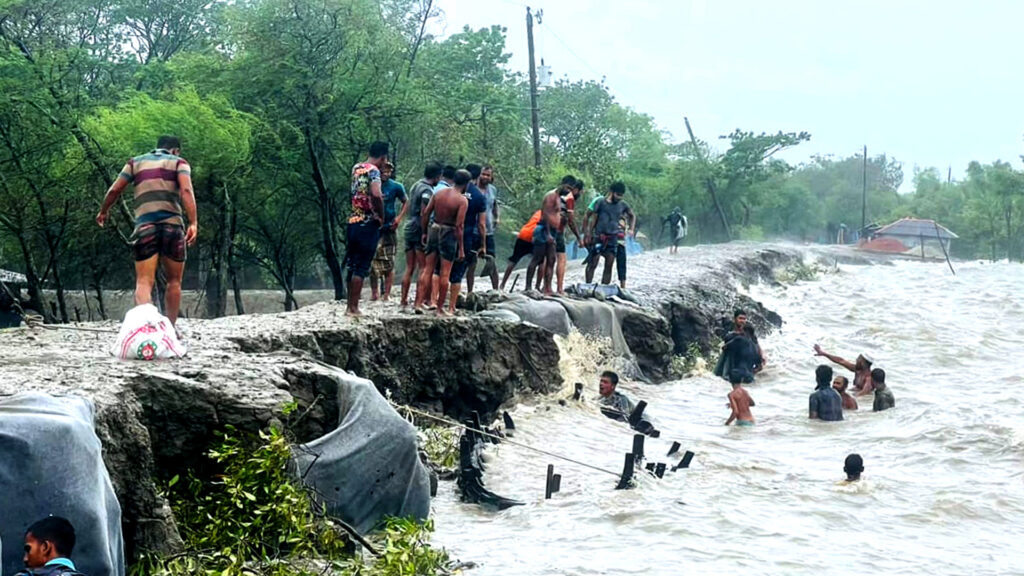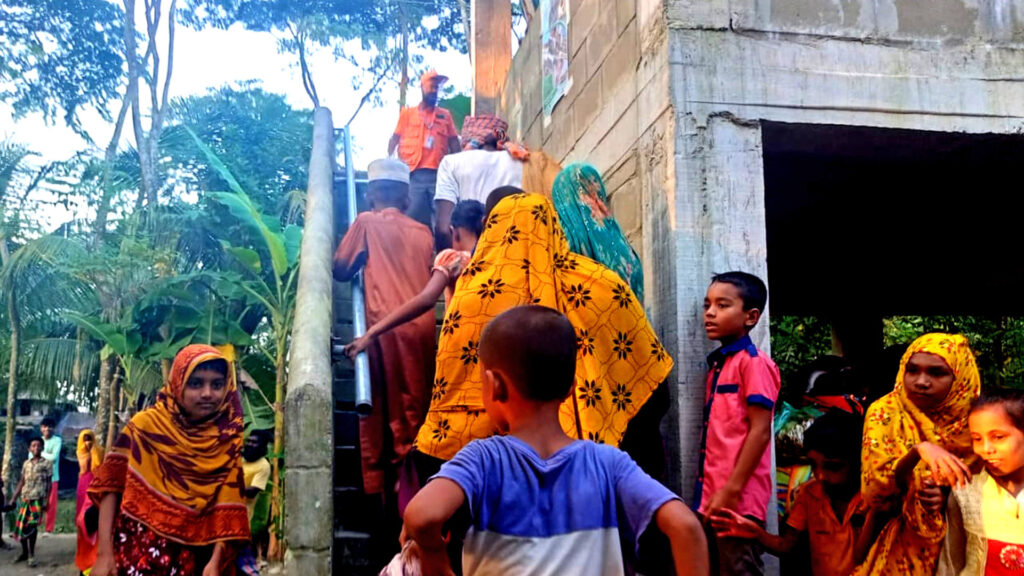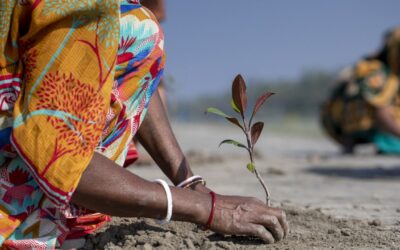3.8 million people were affected by the tropical cyclone that crossed Bangladesh

by Raeed Abd-Allah Chowdhury
May 30, 2024
Cyclone Remal carved a path of destruction through Bangladesh for 40 hours, making landfall between Patuakhali in Bangladesh and Kolkata in India on the evening of 26 May with a maximum wind of 111 km/h. The cyclone flooded dozens of coastal villages and left about 3.8 million people affected through 107 subdistricts in 19 districts. More than 35,000 homes were destroyed, 150,000 damaged and 30 million people were without power. At least 14 people have died including at least 3 that were electrocuted by fallen power lines in the flood water in Dhaka, and 3 others that died trying to get to a shelter. Over 807,000 people were evacuated from vulnerable areas on Sunday to 9,424 cyclone shelters across 19 districts according to the Ministry of Disaster Management and Relief.
However, that was only after causing 2.2 m tidal surges across 16 coastal districts, with half being severely affected including Khulna, Bagerhat, Satkhira, Patuakhali, and Barguna. The latter two suffered from breached embankments, leading to extensive flooding and damage to infrastructure and livelihoods. Homes, agricultural fields, and fishing farms in low-lying areas have been severely damaged or destroyed.

Additionally, The Daily Star reported that the power supply had been cut off to 30.3 million users of Bangladesh Rural Electrification Board (BREB) of its 35.8 million users following the landfall of Cyclone Remal. 27,000 telecom towers have been disrupted, and embankments have been breached at 36 places in Dakop, Paikgasa and Koyra subdistricts of Khulna. The tidal surge has caused saltwater to flood several villages as Bangladesh Water Development Board embankments have been damaged in Paikgasa subdistrict.
Incessant heavy rain for one and a half days inundated several low-lying areas of Chattagram City. Dhaka City and other parts of Bangladesh also experienced heavy rainfall and gusts that severely hampered movement and visibility and flooded multiple neighbourhoods and thoroughfares. Power outages occurred throughout the cities, and fallen trees and debris blocked many roads.

According to Friendship’s initial assessment, 13,289 households were affected within its working areas, of which 5,219 were damaged but repairable, and 273 were completely destroyed. 439 people were injured, but there were no human fatalities within Friendship’s working areas. 89 heads of cattle, however, perished, along with 2,569 poultry. 1,134 acres of crops were damaged; along with 59 tube wells, and 6 that were completely destroyed; additionally 1,558 latrines were damaged, 510 destroyed.
Fortunately, the Government of Bangladesh already had many preemptive measures in place, because of the which the effects of the tropical storm was substantially minimised. Friendship, along with the support of Start Ready – Bangladesh’s Disaster Risk Finance, had taken several preemptive and emergency support actions. The anticipatory and precautionary measures taken were in addition to the preparedness and risk reduction that has been in place for years already, and the quick reaction and limited damages are a testament to the community-initiated disaster risk reduction methods used by the social-purpose organisation, which are complementary to the Government interventions.

Also core to Friendship’s practices is to combine the human health risk factors with those of animals and livestock, as well as nature. And so, the cattle sheds in the cyclone shelters, mangrove plantations and emergency health assistance all work in combination to provide a holistic response; along with the direct involvement of the communities in the planning and implementation of those measures through Friendship Disaster Management Committees (FDMC).
- 40 cyclone shelters managed and repaired by Friendship staff (solar, water, food, sanitation, connecting road, etc.). 3,140 people took shelter, of whom 132 were elderly, 132 were people with disabilities, 562 were children, 1,534 were women and 780 were men.
- Friendship’s own Cyclone Shelter in Kalapara and Cyclone Resilient Houses accommodated approximately 627 people with primary healthcare workers on-site. 517 of them were in the Cyclone Shelter, where they received dry food relief packages. They have started returning to their homes since Tuesday, the 28th.
- 100 Friendship Flood Volunteers disseminated early warning messages and provided evacuation support and rescue assistance jointly with the Government’s Cyclone Preparedness Programme (CPP) volunteers.
- 8 cattle sheds accommodated approximately 400 heads of cattle.
- 502 homes in Shyamnagar, Mongla and Kalapara subdistricts were repaired and strengthened of their houses preceding before the storm.
- Distribution of hygiene kits among 200 families, containing five bars of soap, a pair of buckets and wash mugs, five packets of sanitary napkins, 12 candles and 5 lighters, as well as 10 packages of Orsaline as pre-emptive actions.
- 750 food packs were distributed among households that were at risk and in food crisis. The package includes 2 kg of puffed rice, 1 kg of flattened rice, 1 kg of sugar and molasses, and 10 litres of drinking water per family.
- 400 10-litre water jars with safe drinking water were pre-positioned for immediate use. 15 families received these.
- 12,000 litres of safe drinking water were stored at four Water Treatment Plants and 14,400 litres were reserved in 4 Friendship Cyclone Resilient Houses. 901 litres were distributed.
- Emergency call centre opened in 3 coastal offices with WhatsApp groups connecting all concerned.
- Friendship Hospital Shyamnagar was specially prepared to provide emergency services.
- Precaution/backup arranged for mangrove plantation/nursery and other establishments.
- Friendship provided dry food for 50 Friendship Disaster Management Committee (FDMC) members of the Transitional Fund Project at the Al-Amin Primary School which was being used as a cyclone shelter in Champapur Union.
- The Health Sector is in service with adequate first aid and Procurement has prepared a vendor list to provide materials for quick support.

Friendship is currently conducting a detailed and thorough assessment of the damage and possible after-effects of Cyclone Remal, to determine what further steps need to be taken to rehabilitate the affected people and places, and strengthen against future occurrences. The extant interventions played a substantial role in diminishing the possible effects, both because of pre-existing preparedness measures and anticipatory actions just before the storm.
The Sundarbans, Bangladesh’s silent protector, took the brunt of Cyclone Remal on Sunday, being the first line of defence for the flora, fauna and human populations in Bangladesh’s south. While the human cost of cyclones can be tragically clear, assessing the immediate impact on wildlife after such disasters proves far more difficult. Forest officials have confirmed at least 39 deer perished, with 17 others rescued. Sadly, this is likely just the tip of the iceberg. The entire Sundarbans were flooded in high tide for about 30 hours caused by cyclone Remal, resulting in flowing saline water into the ponds dug to contain fresh water for wild animals and forest-dwelling communities. Carcasses of deer have been found while offices of the forest department have been damaged, according to The Daily Star and Prothom Alo.

Shobhorati Mondal, 89, from Patuakhali reported that the cyclone-resilient house that he took shelter in was a 3-4 minute walk away, and was “no issue to get to at all”. Preceding its construction, the nearest shelter was over 1.5 hours away, which he had to traverse in the middle of Cyclone Amphan three years ago.
People like Shobhorati now need to return to their normal lives and pick up the pieces, and that can only happen if they require reconstruction and access to clean drinking water, food, medicine, hygiene and sanitation can occur. Through the tireless efforts of the Government, the preparedness, response and management of natural disasters have come a long way, with what are still minimal effects compared to the previous decades. Friendship and other NGOs play an additional role in supporting and building on these interventions, through holistic, innovative, locally-led, sustainable and nature-based solutions, that are also built to be scalable and replicable.



